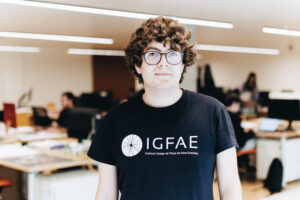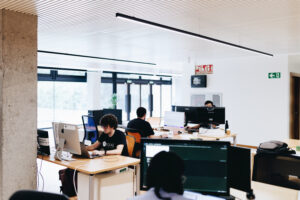IGFAE experiments with quantum teleportation of information to open new doors to future cryptography
The paradox of quantum technologies as the greatest threat and, at the same time, the only solution to guarantee the security of communications in the future is a huge and exciting field of research for the scientific community. Teleportation or quantum teleportation, with which the IGFAE is experimenting, is revealed as a tool with great potential to contribute to the construction of highly secure communication infrastructures such as the one projected by the Complementary Quantum Communications Plan (PCCC)
On September 8, 1966, the first episode of Star Trek was broadcast, featuring its famous transporter, a technology that allowed its characters to teleport instantly from one place to another. We don’t know if the screenwriters of the original version of this iconic series had any idea of quantum physics, but what we do know is that their teleportation fantasies were the utmost representation of science fiction for more than one generation.

Who knows what will happen in the future though at least according to the current laws of physics almost six decades later, this continues to be science fiction. It is not possible to do it with people or objects, but the novelty is that it is feasible when it comes to information, thanks to quantum mechanics. “Instead of transferring the object itself, what is transmitted is its information, using quantum entangled particles. Although it is a real process, it is not instantaneous and still limited by the speed of light,” explains Juan Santos, a researcher at the Galician Institute of High Energy Physics (IGFAE) of the University of Santiago de Compostela (USC).
It is about quantum teleportation (a common denomination in the academic environment), a complex phenomenon that is being explored by the scientific community with all the limitations implied by being a recent field of knowledge. The first research dates back to the 1990s, although the relevance of its potential to contribute decisively to the advancement of quantum technologies is already undeniable.
At the Department of Particle Physics in the Area of Theoretical Physics of the IGFAE, Juan Santos seeks to do his part in this field by opening new paradigms from the knowledge bases. “It is important to point out that this work is not experimental, but theoretical. It is inspired by conjectures and not yet fully understood relationships between gravity and quantum physics,” he specifies. “In particular, we rely on holography, a theoretical proposal that suggests that gravity in curved spaces is related to quantum systems in fewer dimensions. These ideas, while speculative, offer promising clues as to how information could be efficiently propagated by taking advantage of quantum chaos.”
 It may sound strange that chaos holds the key to achieve security in information transport. Still, the quantum world is governed by laws that are often paradoxical when seen from our linear logic. In particular, researchers like Santos want to understand how the chaotic dynamics of a physical system can be harnessed to process and transfer information. The ultimate goal is to improve understanding of what for now are just theoretical conjectures to develop new ways of manipulating information, with potentially profound implications for quantum computing and, especially, quantum communications.
It may sound strange that chaos holds the key to achieve security in information transport. Still, the quantum world is governed by laws that are often paradoxical when seen from our linear logic. In particular, researchers like Santos want to understand how the chaotic dynamics of a physical system can be harnessed to process and transfer information. The ultimate goal is to improve understanding of what for now are just theoretical conjectures to develop new ways of manipulating information, with potentially profound implications for quantum computing and, especially, quantum communications.
Chaos behind order
In quantum physics, chaos refers to the rate at which a perturbation in a particular part of a many-body system is distributed throughout it. “In quantum teleportation, this chaos is responsible for dissolving the signal that is to be sent through the sender system. Although it seems that the signal has been lost because it is scattered throughout the system, in reality, it is still there, only in a coded form,” explains Santos.
To understand this, reference should be made to one of the key properties of quantum mechanics: entanglement, which appears in quantum systems with more than one particle. In essence, it is a phenomenon whereby two or more quantum particles become interdependent, so that the state of one is directly related to that of the other or others, regardless of the distance separating them.
“The quantum rules allow for stronger correlations between particles than in classical physics. When it comes to teleportation, a highly entangled type of quantum state is used, shared between the sender and receiver. Once the two parties are ready, the signal to be sent is introduced into the sender system and then dissolves in it due to its chaotic dynamics,” explains the IGFAE researcher. This means that, temporarily, the information cannot be recovered without access to the entire system. “It can be understood as a kind of encryption that appears naturally due to the chaos.”
This occurs because the signal is inaccessible until the moment it reappears. The key to recovering the information lies in the fact that entanglement will make the receiver system act as a mirror of the sender “in which things happen in reverse, as if rewinding a film,” illustrates Santos, explaining how the information reappears in the receiver system.
The fact that chaos can be used as an encryption tool anticipates potential applications for protecting the security of large-scale communications. “In particular, we could think of a quantum internet in which a set of connected devices is the system with chaotic dynamics. Thus, based on such kind of protocols, perhaps information could be sent securely since it would only be accessible to the sender and receiver,” describes the researcher. Therefore, the results of this project could contribute to solving the great paradox that implies that quantum technologies are, at the same time, the greatest threat yet the solution to the security of our communications.
Quantum simulation
The experiments that are part of this research are only theoretical because it is still impossible to physically realize the processes in the laboratory, mostly because chaos-mediated quantum teleportation requires very precise control of the largest possible quantum systems. Until that point is reached, the solution is to simulate these phenomena on a computer. And to simulate quantum processes, you must use quantum computers.
“In a classical simulation, a conventional computer performs the mathematical calculations needed to solve a physical problem. What happens is that when simulating quantum systems, the computational resources required increase exponentially, making it impossible to study sufficiently large systems,” explains Santos. The alternative is quantum simulation, which is capable of recreating these systems, precisely by applying the laws of quantum physics.
In any case, being something so new and complex, the researcher adds that “creativity is needed when designing the experiment, it is not always obvious what kind of processes must be carried out to draw any significant conclusions.”
IGFAE is already cooperating in this project with the Galicia Supercomputing Center (CESGA) and the University of Grenoble, and hopes to increase the number of collaborators in the future. There is a lot of work ahead for the research that is being developed within the framework of the Complementary Quantum Communications Plan (PCCC) from its foundations. “The main objective of the PCCC is to boost the quantum communications industry in Spain to create a highly secure infrastructure. Our research does not address the deployment of this network in the short or medium term but seeks rather to find the physical phenomena on which it can be sustained in the longer term,” Santos explains.
The quantum future
Although the rules of quantum mechanics have been established for almost a century, the phase of understanding how to use them to process information is very recent. “This makes everything very volatile and forces us to study the contributions of other scientists on a daily basis, even if they don’t do exactly the same as we do, and to look for ways to incorporate their ideas or techniques into our work,” says Juan Santos.
This scientific effervescence explains why, in a field as dynamic as quantum technologies, even the most incipient and theoretical fields of knowledge have very promising prospects for evolution. According to the researcher, “chaos-mediated quantum teleportation is a relatively new field of research and it has only been in the last two or three years that we began to understand its theoretical foundations. In the next five years, I expect this understanding to advance significantly, which could allow the first experiments to demonstrate its operation in practice.”
Santos hopes that the contributions being made by the IGFAE team to prepare the initial state for teleportation and understanding the role of chaotic dynamics will help put the center on the map. “In Santiago, we are very new to this field, so we are at the point of positioning ourselves and starting to become known in the community.”
Contact: juansantos.suarez@usc.es ; tf.pena@usc.es
Webs:
https://es.linkedin.com/in/juansansu
https://citius.gal/team/tomas-fernandez-pena
Publications:
Faílde, D., Santos-Suárez, J., Herrera-Martí, D. A., & Mas, J. (2023). Hamiltonian Forging of a Thermofield Double. arXiv preprint arXiv:2311.10566. https://arxiv.org/abs/2311.10566
Berenguer, M., Dey, A., Mas J, Santos-Suárez, J., Ramallo, A.V. (2024). Floquet SYK wormholes. arXiv:2404.08394. https://arxiv.org/abs/2404.08394
